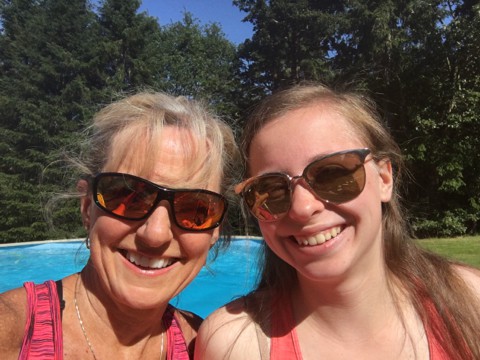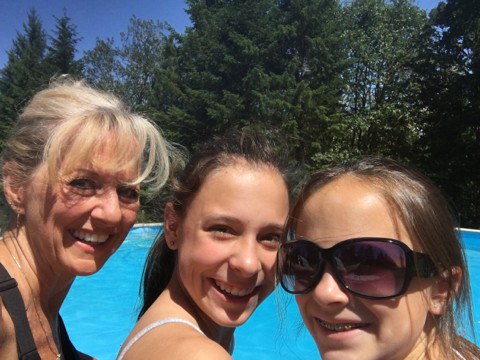Linda F. realized she had hearing loss in her 20s, discovering she had normal low-frequency hearing but high-frequency hearing loss. After costly hearing aid purchases were not helping her to the level needed, she asked doctors if there was anything else that could be done to help her hear. Unfortunately, she was told she needed to just “live with it.” Tired of dealing with her hearing situation when work meetings became even more exhausting and sometimes embarrassing, Linda learned Cochlear had released its Cochlear™ Nucleus® Hybrid™ Implant System* and was thrilled for the chance to hear all frequencies of sound again with a hybrid implant. See how her life has transformed:
“I heard normally until my early 20s. When I was pregnant with my first child, I became concerned about my sudden inability to adequately understand speech. I had my hearing tested shortly after, and it showed my low tones were normal, but my high tones were very poor; both ears were basically the same.

I got a hearing aid then for my right ear (costs prohibited buying for both ears at the same time), and I wore it for quite some time, until I acknowledged to myself that the background noises were louder than the sounds I intended to hear. At the time, it seemed like the purpose of my hearing aid was simply to turn up the volume on all tones, not just the high tones I needed amplification on.
Off and on, I purchased new hearing aids, but they never really helped to the level I needed. I remember in my mid-30s asking my ear, nose and throat doctor (ENT) if there was a surgery I could do to improve my hearing and being told there was nothing that could be done, and I must simply learn to live with it. After all, I was not ‘deaf,’ since my low tones were normal. I continued to have my hearing tested regularly, and each test looked very similar, both ears had similar patterns of great low tones, immediately dropping off to poor high tones, a classic ‘ski slope audiogram.’ I faithfully wore hearing aids, although they were not tremendously effective.
A new hearing solution
Fast-forward 30+ years, I visited a new ENT and audiologist, who both throughout the visit asked me, ‘How do you manage?’ It seemed so funny to me, because the results of my hearing test were the same as I had received over the years without much fluctuation. I explained how I played tricks to pretend I could hear, like ensuring I arrived to meetings early enough to position myself in the room where I could see everyone’s faces for lip-reading, using closed captions on a TV, avoiding telephone conversations and emailing instead, etc. The ENT advised me there were recent improvements in Hybrid 1 cochlear implants, for which she felt I might be a great candidate, and she would be willing to refer me to a cochlear implant surgeon if I was interested. Things took off from there!
I received the Cochlear Hybrid Implant in my right ear in June of 2016 and was activated with the Cochlear™ Nucleus® 6 Sound Processor three weeks later. I received the Cochlear™ Nucleus® Kanso® Sound Processor as a backup processor in March of 2017, and I loved the off-the-ear option so much, it soon became my primary processor.
Success with new sounds
 Immediately after activating my new Cochlear Implant in June of 2016, I could hear sounds I had never heard. My refrigerator beeps when the door is left ajar. My clothes dryer plays a little tune when it completes its cycle. Who knew?! After just a few months, I found I could hear speech and conversations without straining to understand. I could hear birds, crickets, clocks…the list goes on.
Immediately after activating my new Cochlear Implant in June of 2016, I could hear sounds I had never heard. My refrigerator beeps when the door is left ajar. My clothes dryer plays a little tune when it completes its cycle. Who knew?! After just a few months, I found I could hear speech and conversations without straining to understand. I could hear birds, crickets, clocks…the list goes on.
With the tremendous success of my first Cochlear Implant, I began pursuing the same for my other ear. I received my second implant in August of 2017 and was activated with another Kanso Sound Processor two weeks later. I received the Cochlear™ Nucleus® 7 Sound Processor shortly after, but I love my Kanso Sound Processors so much, the Nucleus 7 Sound Processor has become my backup processor for my left ear. Because I was fortunate enough to retain my low-tone residual hearing, I have no need for the acoustic component 2 that many Hybrid users wear. My second Cochlear Implant has been wonderful in providing directionality and clarity.
Becoming a strategic participant at work again
In my role as Chief Financial Officer for a prominent healthcare organization, I attend numerous meetings and complex strategic-planning sessions. What was previously exhausting to interpret has now became exhilarating. What was laborious and sometimes embarrassing (I cannot count the number of times I have chimed in with a response that had nothing to do with the question asked!), became thoughtful and tactical. Rather than being simply an observer, I became an active, strategic participant at work!
My Cochlear Implants have enhanced my personal life tremendously. I am able to have conversations with people in the car without getting carsick turning around to see faces to lip-read! We can have the television volume at a reasonable level and even have conversations while we are watching it.
Hearing voices while playing in the water
The accessories Cochlear offers to accompany its processors are outstanding. I particularly like the Aqua+ accessory 3 that allows me to swim in the pool with my family, without concern about the processor getting wet or damaged. I could never have imagined being able to hear my granddaughters’ voices while we are diving for pool toys, splashing each other or playing water games.
Thank you, Cochlear, for creating an option for people like me, those who are completely missing their high tones, but have maintained their low tones, to hear in a way that improves our quality of life. I am thrilled with my Cochlear Implants because any assistance in improving my hearing is an awesome blessing toward a better life!”
Are you struggling to hear high tones, but still have good low tone hearing? Look into Cochlear’s Hybrid Implant System to try and improve your hearing quality like Linda.
- The Hybrid L24 Implant is approved in the US only for adults 18 and older.
- The Acoustic Component should only be used when behavioral audiometric thresholds can be obtained and the recipient can provide feedback regarding sound quality.
- The Kanso Sound Processor with the Aqua+ is water resistant to level IP68 of the International Standard when used with LR44 alkaline or nickel metal hydride disposable batteries. The Nucleus Aqua+ accessory is IP68 rated and is approved for use with rechargeable batteries and is not approved for use with the acoustic component.